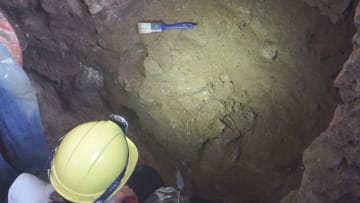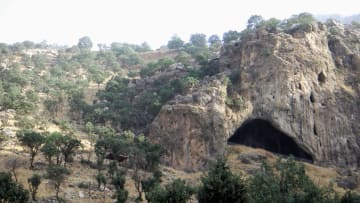دبي، الإمارات العربية المتحدة (CNN) -- يسعى تحليل جديد للجينومات القديمة إلى تعميق فهم العلماء للحمض النووي لإنسان نياندرتال الذي يحمله البشر في أوروبا وآسيا، وهي آثار وراثية قد يكون لها فائدة طبية اليوم.
وقد تتبعت النتائج التي تم التوصل إليها ونُشرت في مجلة "Science Advances" الأربعاء، الإرث الوراثي لأنسباء جنسنا البشري القدامى، الإنسان العاقل، بدقة أكبر، وذلك بفضل الكتلة الحيوية من البيانات المهمة جدًا، وفقا لما ذكره الباحثون.
ويمكن لغالبية البشر الأحياء اليوم أن يجدوا نسبة صغيرة جدًا من الحمض النووي الخاص بهم تعود إلى إنسان نياندرتال، نتيجة لقاءات جنسية ما قبل التاريخ بين أسلافنا وأشباه البشر المنقرضين الآن في العصر الحجري، قبل اختفاء الأخير منذ حوالي 40 ألف عام.
ولكن، الحمض النووي للنياندرتال أكثر وفرة بقليل في جينومات سكان شرق آسيا.
وقد حيّر هذا التناقض العلماء لفترة طويلة لأنه تم العثور على بقايا إنسان نياندرتال على نطاق واسع في جميع أنحاء أوروبا والشرق الأوسط، لكن ليس شرق جبال ألتاي في آسيا الوسطى.
وقال ماثياس كورات، أحد المشاركين في الدراسة، والمحاضر البارز في علم الوراثة والتطور في جامعة جنيف: "الأمر المحيّر يتمثّل بأنّ المنطقة التي لم نعثر فيها على أي بقايا لإنسان نياندرتال، يوجد بها المزيد من الحمض النووي للنياندرتال".
وأضاف كورات أنّ الحمض النووي للنياندرتال يمثّل نحو 2% كمعدل وسطي من التركيب الجيني للأشخاص في أوراسيا، بينما في شرق آسيا يمكن أن تصل النسبة إلى 4%.
وتوصّل كورات وزملاؤه في جامعة جنيف إلى تفسير هذا التناقض من خلال تحليل توزيع الحمض النووي الموروث من إنسان النياندرتال في جينومات البشر على مدى الأربعين ألف سنة الماضية.
وأوضح كورات: "لقد بدأنا بالحصول على بيانات كافية لوصف النسبة المئوية للحمض النووي من إنسان نياندرتال بشكل أدق بجينوم العاقل في فترات معينة من عصور ما قبل التاريخ".
ورأى الباحثون أنه بمرور الوقت، لم يَبدُ توزيع الحمض النووي للنياندرتال دومًا كما هو حاليًا.
تخفيف الجينوم
واستخرج فريق الدراسة معلومات من قاعدة بيانات تضم أكثر من 4000 جينوم قديم من جميع أنحاء أوروبا وآسيا جمعها فريق بقيادة الدكتور ديفيد رايش، أستاذ علم الوراثة وعلم الأحياء التطوري البشري بكلية الطب في جامعة هارفارد ببوسطن.
ووجد الباحثون أن جينومات الإنسان العاقل من العصر الحجري، الذي عاش كصياد وجامع للثمار في أوروبا بعد انقراض إنسان النياندرتال، تحتوي على نسبة أعلى قليلاً من الحمض النووي للنياندرتال مقارنة بأولئك الذين عاشوا بآسيا، في العينات التي يزيد عمرها عن 20 ألف عام.
واستنادًا إلى ذلك، خلص فريق الدراسة إلى أن النمط الحالي للنسبة الأعلى للجينوم من أصل إنسان نياندرتال في المجموعات السكانية الآسيوية، مقارنة بتلك الموجودة في أوروبا، يجب أن يكون تطور ربما في مرحلة لاحقة، على الأرجح خلال الفترة الانتقالية للعصر الحجري الحديث، عندما بدأت الزراعة تحل محل الصيد وجمع الثمار كوسيلة للعيش لفترة تتراوح بين حوالي 5 و 10 آلاف سنة.
في هذه الحقبة، بدأ المزارعون الأوائل من الأناضول، أي ما يُعرف اليوم بغرب تركيا وبحر إيجه، بالاختلاط مع الصيادين وجامعي الثمار الموجودين في غرب وشمال أوروبا. وأدى ذلك إلى تراجع نسبة الحمض النووي للنياندرتال في الجينومات الأوروبية خلال هذه الفترة.
وأوضح كورات: "الأمر يتمثّل بأنّ لديهم أسلافًا أقل من إنسان نياندرتال، لذا فقد خففوا (سلالة إنسان نياندرتال) في السكان الأوروبيين".
وعقّب أنّه من غير الواضح كيف تم هذا التحول في آسيا بسبب النقص النسبي في المعلومات. وشملت الدراسة 1517 عينة من أوروبا مقابل 1108 عينة من آسيا، وهي مساحة أكبر بأربعة أضعاف.



